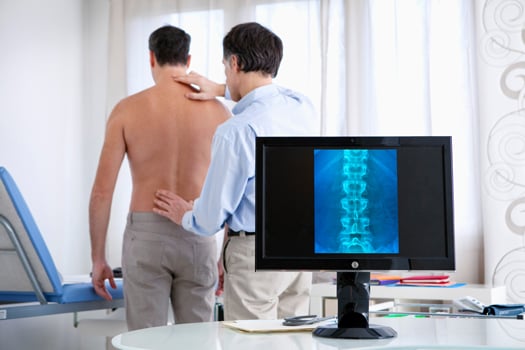
Spinal discs can sometimes herniate quickly, as may be the case if there is some type of trauma, such as a hard fall or a car accident. However, it is more common for spinal discs to gradually herniate, which brings us to the four stages of spinal disc herniation. This article will explain more about what to expect when one of the discs that supports your spine develops a weak exterior shell that allows inner material to get out.
1. Bulging
Bulging occurs when disc material on the inside of the spinal disc moves around in a way that causes the disc to extend abnormally to one side. When this happens, a nearby spinal nerve can become irritated, although this is not always the case. This is when the nucleus pulposus—the name for the inner disc material—slightly pushes against the outer shell. A bulging disc is not a serious issue for most people. In fact, it is often possible for the disc material to shift again in a way that returns the disc to its normal shape.
2. Disc Protrusion
During this stage, the disc material reaches the annulus fibrosus, which is the name for the outer shell mentioned above. The disc material is still inside the outer shell, although the spinal disc bulge is more noticeable, which often means an increase in discomfort. You may start to notice nerve-based symptoms such as numbness and tingling sensations at this point.
3. Disc Extrusion
At this stage, the inner disc material goes through the outer shell. Once the inner material breaks through, you may experience severe discomfort, such as lower back pain that extends downward if the affected disc is in the lumbar area, which is common with disc herniation. At this point, it is often possible for patients to benefit from nonsurgical treatments that include:
• Physical therapy
• Posture correction exercises
• Steroid injections and other medications
• Hot and cold therapy
• Modification of activities
At this stage, the related symptoms may be manageable or completely subside with the help of the treatments mentioned above. However, it is still possible to have pain flare-ups with certain movements.
In some cases, surgery may eventually be recommended. Whether this applies to you depends on which nerve is irritated and how the protruding disc material is irritating or compressing it. The good news is surgery is only necessary about 10 percent of the time at this stage.
4. Disc Sequestration
Disc sequestration occurs when the inner disc material comes out of the shell altogether and fully detaches from the spinal disc. This is serious and often requires a surgical procedure called a discectomy. It can also contribute to some equally critical issues, especially if it gets lodged within the spinal canal. In this instance, you may have severe nerve irritation. At this point, it is not uncommon for patients to be bedridden due to the severity of the discomfort.
If you have a herniated disc that is not responding to conservative treatment, a discectomy or a less invasive microdiscectomy may be recommended. Although this is generally one of the most successful back surgery procedures, patients with a large hole in the outer ring of the disc have a significantly higher risk of reherniation following surgery. Often, the surgeon will not know the size of the hole until beginning surgery, and having a large hole in the outer ring of the disc more than doubles the risk of needing another operation. A new treatment, Barricaid, is a bone-anchored device that closes this hole, and 95 percent of Barricaid patients did not undergo a reoperation due to reherniation in a 2-year study timeframe. This treatment is done immediately following the discectomy—during the same operation—and does not require any additional incisions or time in the hospital.
If you have any questions about the Barricaid treatment, ask your doctor or contact us at 844-288-7474.
For full benefit/risk information, please visit: https://www.barricaid.com/instructions.


Comments